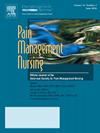Neonatal Pain Management
IF 1.6
4区 医学
Q2 NURSING
引用次数: 0
Abstract
The purpose of this presentation is to present an evidence-based update related to neonatal pain management. By 23-25 weeks, the infant nervous system is able to perceive pain. It has been well-documented that NICU infants undergo 7.5 -17.3 painful procedures per day. Nurses play a key role in providing evidence-based interventions to prevent procedural pain. Neonates are completely dependent upon caregivers, especially nurses at the bedside, to recognize (assess) pain, provide appropriate multimodal interventions, and reassess effectiveness. Bedside nurses caring for neonates and infants must be skilled in identifying potential sources of pain and assessment of pain in a completely vulnerable population. Poorly controlled pain negatively impacts the developing brain leading to negative short and long term outcomes including hyperalgesia, altered cardiovascular responsiveness to nociceptive stress into adulthood, reduced white matter integrity, neuronal loss, long-term behavioral changes and many other negative sequelae from poorly controlled pain. While managing neonatal pain is vital to promote brain growth, nurses must be aware of unique aspects of pharmacologic interventions due to immature organ systems as well as potential implications associated with rapid brain development and analgesia administration. Newer modalities such as regional analgesia and medications such as dexmedetomidine show promise in relieving pain while minimizing harmful side effects. Additionally, nurses have the primary responsibility for utilization of evidence-based, non-pharmacological interventions to prevent pain and minimize the potential for harmful side effects which can be associated with pharmacologic interventions.
求助全文
约1分钟内获得全文
求助全文
来源期刊

Pain Management Nursing
医学-护理
CiteScore
3.00
自引率
5.90%
发文量
187
审稿时长
>12 weeks
期刊介绍:
This peer-reviewed journal offers a unique focus on the realm of pain management as it applies to nursing. Original and review articles from experts in the field offer key insights in the areas of clinical practice, advocacy, education, administration, and research. Additional features include practice guidelines and pharmacology updates.
 求助内容:
求助内容: 应助结果提醒方式:
应助结果提醒方式:


